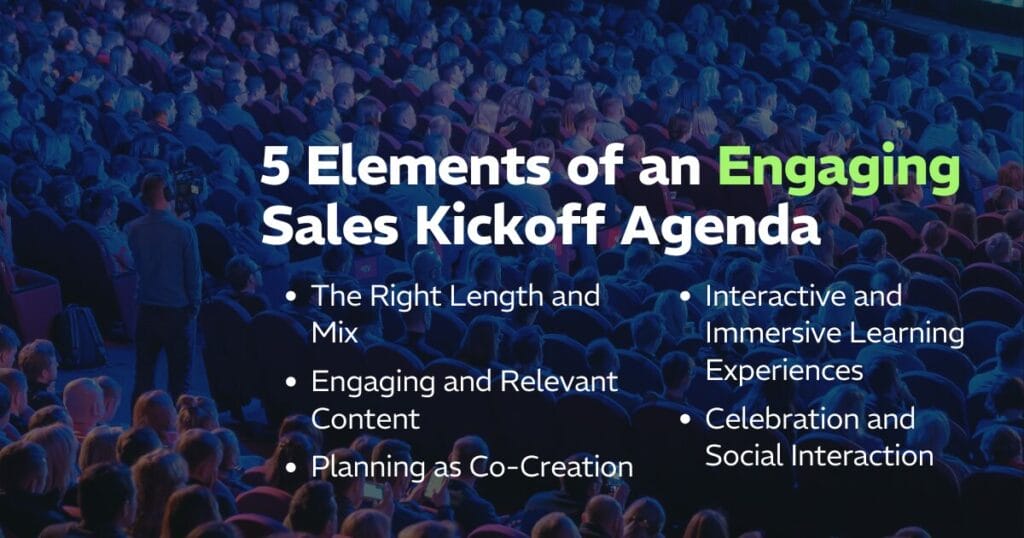Imagine stepping onto the stage as the lights dim and the room buzzes with the collective energy of a sales team eager and ready to take on the world. This isn’t just any meeting — it’s your sales kickoff (SKO) meeting. It’s the starting line of your team’s most successful year yet, the place where strategies are ignited, skills are sharpened and a shared vision is vividly cast.
Over my career as a sales leader, speaker and business owner, I’ve learned that the magic of a memorable SKO doesn’t happen by accident. It’s a meticulously crafted experience where every detail counts and every moment is an opportunity to inspire and elevate.
We need successful SKO meetings because the job is tougher. Salesforce research tells us that 69% of salespeople say sales is getting harder. Not only is the job getting more difficult, we get less time with prospects and customers: Only 29% of customers prefer talking to a salesperson over self-service, according to HubSpot.
I’m sharing my advice for how to create SKO meetings that get the details right while capturing your team’s imagination and catapulting their performance. From setting an SKO agenda to following up after the meeting, learn how to make kickoffs count.

3 Goals for Your Sales Kickoff Presentation
In this era of “return to profitable growth,” your kickoff needs to inspire behaviors and habits that lead to lasting business results. Start with the end in mind: What does a successful SKO meeting look like for your company? Identify the desired outcomes and how the event can set the stage for achieving these goals throughout the year.
Ask yourself questions like:
- What’s the outcome that we’re trying to drive?
- Where do we want to be a week after the meeting ends? What about three months, six months or nine months?
When you set the big-picture vision, you can then build the content and shape the experience around that. While every organization’s kickoff looks a little different, here are a few common goals to consider.
Energize Your Sales Team
Gathering your sales organization together is a tremendous opportunity to get them excited about their work, their goals and the organization’s prospects. Just the act of coming together and hearing from top leaders can get you partway there.
But you also need executive presence to deliver an SKO that gets your people excited about the work to come and focuses them on what they must do next. Everyone who presents needs the right demeanor and communication style to inspire your sales team’s confidence. Your sales team should leave the kickoff optimistic about the organization’s future and their ability to innovate, deliver for customers, and compete and win in the marketplace.
Create Alignment
Every SKO meeting should align your sales team with business goals and how they’ll achieve them. The SKO agenda itself should align with business objectives so you can plan more targeted content, training and networking. Every discussion, workshop and breakout session should tie back to business goals.
Alignment also takes place outside formal sessions. It’s personal and one-to-one — the conversations you have and the relationships you nurture throughout the event. When you align sellers to organizational purpose, you help them feel like they’re connected to something larger than themselves. That leads to better relationships inside the company and with their customers..
Help Your Sales Team Level Up
Your SKO agenda should have activities that generate excitement and create alignment, but don’t forget the work of making your sellers better. They should leave the kickoff meeting more prepared to hit their goals, more effective as sellers and more skilled at creating deep relationships with customers. They should be able to articulate value through the decision cycle more consistently.
When I give a sales keynote, I try to blend inspiration and actionable content. I want people to feel the emotional resonance and get excited about what they’re doing. After all, there’s a lot of reason for optimism. I think it’s the greatest time in the world to be in sales. But I also want people to think more deeply about their approach to the customer and to the marketplace so they’re positioned to win — and win more consistently.

5 Elements of an Engaging Sales Kickoff Agenda
Event planning is essential to a successful SKO. A seamless kickoff looks easy only because of the careful planning and hard work carried out in the weeks leading up to the event. As someone who’s participated in, spoken at and helped plan these crucial meetings, here are some sales kickoff ideas for you to consider.
The Right Length and Mix
The best sales organizations today are blending in-person and virtual events to get the most impact throughout the year. Many companies have one big annual meeting in person that lasts two or three days. They supplement this with virtual meetings as the year progresses to maintain connection and throughputs. Your mix may vary, but keep in mind the flexibility of virtual events and the power of in-person connection.
The length of your event affects your agenda. With a SKO lasting two or three days, you can do a little bit of everything: the “state of the union” speech about the organization, customer panels and focus groups, product-specific training, sales scenarios, celebrations and more. And you can also get people really excited, engaged and inspired about the future.
Engaging and Relevant Content
Your sales kickoff is a time to celebrate and enjoy each other’s company. But sales executives and C-suite leaders also want to drive an outcome or result. That’s where getting your content right is essential. Don’t just copy another sales playbook — your SKO agenda should match the needs of your company and the marketplace. The keynotes, breakout sessions and workshops that work for one business might not make sense for yours.
Aim for content that is inspiring yet actionable. I think storytelling in sales is such an important part of how we relate and connect. And it’s certainly a big part of sales excellence. So is education — arm your sales team with practical tools and strategies they can immediately apply.
When you bring in outside speakers, look for powerful storytellers who will tailor their talks to your company’s needs and competitive landscape. They should be engaging and powerful storytellers, not speakers who recite a long list of data points. Great speakers can help your sellers shift their thinking in terms of what actually drives the value exchange and competitive advantage.
Planning as Co-Creation
A great kickoff isn’t a one-person job. Make sure you’re Involving the sales team and other key stakeholders throughout the planning process. Ask for their input on what they most need. What’s on their hearts and minds? What are the opportunities they want to capitalize on? What are the competitive barriers?
Involving and listening to your team can make SKOs more tailored and effective, even if it feels slower and more uncertain at first. Remember that the magic of creation is in taking the risk. By adopting a co-creation mindset, your content and activities will directly align with the team’s real-world experiences and obstacles.
Interactive and Immersive Learning Experiences
Presentations are a staple of any sales meetings, but sitting in ballrooms and conference rooms all day can deflate your team instead of energizing them. Stop being passive and embrace an SKO that’s interactive and engaging.
There’s no substitute for an engaging SKO where everyone is visioning together, celebrating and solving problems. How can you make the content experiential and immersive? Mix in hands-on training, discussion-filled breakout sessions, networking breaks and other activities that allow participants to practice and apply what they learn in real time.
Just as importantly, give your content and ideas room to breathe. Many times, we don’t give people enough time and space to absorb what they’ve just learned or discuss it with their colleagues.
Celebration and Social Interaction
I’m a big believer in leveraging the power of celebration. For one thing, it’s OK to have fun at work. But recognizing and celebrating your people’s achievements contributes to further success. O.C. Tanner found that workplaces that build in regular recognition see attrition decline by 29% and burnout by 80%.
Celebration doesn’t have to exclude learning. Schedule team-building activities to foster collaboration and camaraderie, including group exercises, networking opportunities and social events. And leave room for unscheduled time for people to spontaneously mingle, interact, ideate and form closer bonds.
How to Follow Up Your Sales Kickoff
The best SKO meetings get everyone excited for the potential of the year ahead of them. But that energy and enthusiasm can quickly dissipate if not followed by focused actions. Successful SKOs help your sales team decide what to do differently — and better — after the meeting ends to drive business results.
Maintain the Momentum
The most important minute of a meeting or a conference is 8:01 a.m. the day after. What will you do at the beginning of the next workday to ensure that the SKO translates into lasting, measurable success?
Start by organizing debrief sessions immediately after the event. These sessions should focus on discussing actionable steps each team member can take based on the insights and strategies discussed during the kickoff. Explore how to integrate those learnings into daily routines — cementing the commitment to new ideas and practices introduced during the event.
Maintaining momentum requires ongoing communication and collaboration. A midyear meeting can help reinforce the goals and rejuvenate your team. So can virtual events throughout the year. Augment those formal gatherings with some type of ongoing connection, learning and collaboration. One-on-ones between managers and employees are a perfect time to check on alignment and progress toward goals, for example.
Track KPIs
For a sales kickoff to be successful, you must measure impact. Begin by defining key performance indicators (KPIs) that align with the strategic objectives set during the SKO. These might include metrics such as an increase in sales volume, growth in new accounts or improved customer retention rates. Three of my favorite KPI examples are qualified inbound leads, sales cycle length and customer evangelism.
Make sure you’re regularly monitoring and reporting on these metrics, both to ensure accountability and to celebrate progress and success. Where you find shortfalls, use the data to identify what’s going wrong and how you can take corrective action and reestablish alignment.
Build the Foundation for Sales Kickoff Success
A well-executed SKO can be a transformative experience for your sales team. It’s an opportunity to reset, realign and reinvigorate their efforts in an economy that’s only getting more complex and competitive.
By focusing on energizing and aligning your salespeople, enhancing their skills, delivering impactful content and creating interactive and immersive experiences, you can set the stage for a year of exceptional sales performance. Your next SKO could be the first step toward creating a more talented sales team, better culture and lasting competitive advantage.










